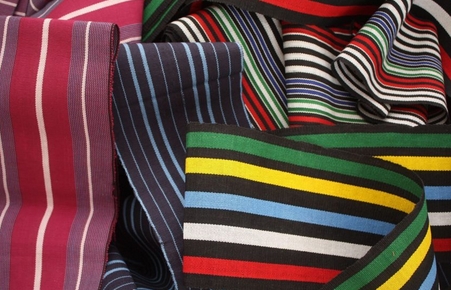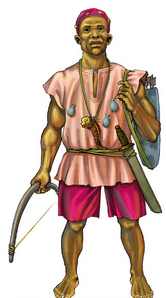
support@yorubalibrary.com
+2348073529208, 07038599574

Yoruba weaving and textile art are integral aspects of the cultural heritage of the Yoruba people, predominantly found in southwestern Nigeria. This rich tradition encompasses various techniques and styles, reflecting the social, cultural, and economic life of the Yoruba community. This article delves into the materials, methods, and significance of Yoruba weaving and textile art.
Historical Background
The history of Yoruba weaving dates back centuries, with evidence of sophisticated textile production in ancient Yoruba kingdoms such as Ife and Oyo. Textiles were not only used for everyday clothing but also played a crucial role in rituals, ceremonies, and as symbols of status and identity.
Materials Used in Yoruba Weaving
Cotton
Cotton is the primary material used in Yoruba weaving. The cultivation of cotton and its transformation into thread form the foundation of Yoruba textile art. Cotton fibers are spun into yarn, which is then dyed and woven into fabric. The quality of the cotton and the skill of the weaver determine the texture and durability of the final product.
Silk
Silk, although less common than cotton, is also used in Yoruba weaving. Silk threads are incorporated to add luster and enhance the visual appeal of the fabric. The use of silk is often reserved for special garments and ceremonial attire, highlighting its luxury and significance.
Dyes
Natural dyes derived from plants, minerals, and insects are essential in Yoruba textile art. Indigo, obtained from the leaves of the indigo plant, is the most famous dye, known for its deep blue color. Other natural dyes include camwood (red), kola nut (brown), and various leaves and roots providing a spectrum of colors. These dyes are used in various techniques, such as tie-dye (adire) and batik.
Techniques in Yoruba Weaving
Aso-Oke Weaving
Aso-Oke is the most renowned Yoruba textile. It is a hand-woven fabric made from cotton or silk threads. The weaving process involves using narrow looms to create long strips of cloth, which are then sewn together to form larger pieces. Aso-Oke is traditionally worn during significant events such as weddings, festivals, and chieftaincy ceremonies. There are different types of Aso-Oke, including:
• Etu: A dark indigo and white striped pattern.
• Sanyan: A beige and brown pattern made from wild silk.
• Alari: A rich red fabric often used for special occasions.
Adire Dyeing
Adire is a traditional Yoruba method of resist dyeing using indigo. There are various techniques within Adire, including:
• Adire Eleko: Using cassava paste or rice starch to create intricate patterns on fabric before dyeing.
• Adire Oniko: Tying small sections of cloth with raffia to create resist patterns.
• Adire Alabere: Stitching the fabric with raffia threads before dyeing to produce unique designs.
These techniques result in beautifully patterned textiles that are both functional and artistic.
Batik
Batik is another dyeing technique used by Yoruba artisans. It involves applying wax to fabric in specific patterns before dyeing. The wax resists the dye, creating intricate and colorful designs once the wax is removed. Yoruba batik is known for its detailed motifs and vibrant colors, often depicting cultural symbols and natural elements.
Cultural Significance
Identity and Status
Yoruba textiles are more than just clothing; they are symbols of identity and status. Different patterns, colors, and styles convey various messages about the wearer's age, social status, marital status, and more. For example, the type of Aso-Oke worn can indicate one's social rank or the significance of the event they are attending.
Rituals and Ceremonies
Textiles play a vital role in Yoruba rituals and ceremonies. Specific fabrics are used in rites of passage such as births, marriages, and funerals. During these events, textiles serve not only as attire but also as symbols of cultural continuity and communal identity.
Economic Contribution
The production and sale of textiles contribute significantly to the Yoruba economy. Weaving and dyeing are traditional crafts passed down through generations, providing livelihoods for many artisans. Markets for Aso-Oke, Adire, and other textiles attract local and international buyers, promoting Yoruba culture globally.
Modern Influence and Adaptation
Contemporary Fashion
Yoruba textiles have influenced contemporary fashion, both within Nigeria and internationally. Designers incorporate traditional fabrics and techniques into modern clothing, creating unique and culturally significant fashion statements. This fusion of old and new helps preserve traditional practices while keeping them relevant in today's fashion industry.
Global Reach
The global appreciation for African textiles has led to increased interest in Yoruba weaving and dyeing techniques. Artisans and designers collaborate worldwide, showcasing Yoruba textiles in international exhibitions and fashion shows. This global reach not only promotes cultural exchange but also provides economic opportunities for Yoruba weavers and dyers.
Conclusion
Yoruba weaving and textile art are crucial elements of the Yoruba cultural heritage. Through materials like cotton and silk and techniques such as Aso-Oke weaving and Adire dyeing, Yoruba artisans create textiles that are rich in history, cultural significance, and artistic beauty. These textiles continue to play an essential role in contemporary fashion and global cultural exchanges, ensuring that the traditions and skills of Yoruba weavers and dyers are celebrated and preserved for future generations

Learn about the Yoruba concept of Ìwà Pẹ̀lẹ́ (good…

Learn special praises for Divine Being and Creator…